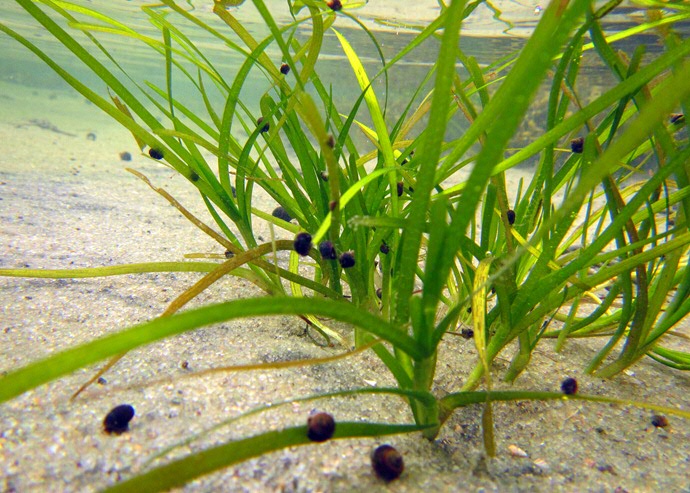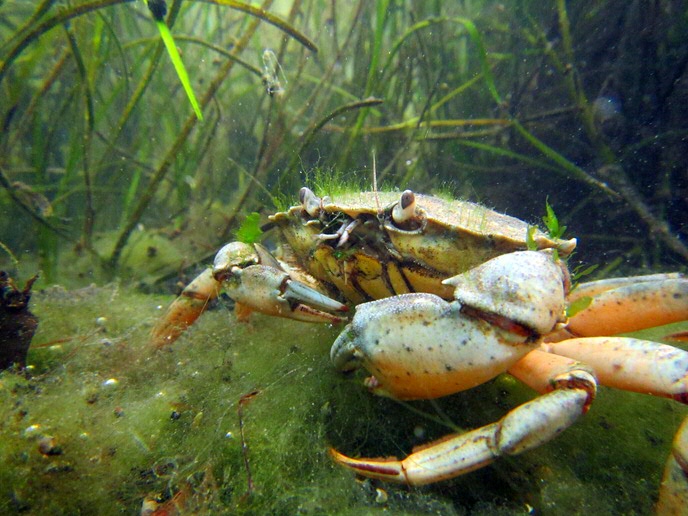Seagrass restoration threatened by fungi

Dutch biologists have discovered that seagrass seed is killed by waterborne fungi that are related to the well-known potato blight. These fungi, which have not previously been found in seawater, hinder seed germination and thus prevent the restoration of seagrass. The biologists, including Laura Govers of the University of Groningen, published their results on August 24 2016 in Proceedings of the Royal Society B.
The seawater fungi that are to blame (Phytophthora gemini and Halo Phytophthora sp. Zostera) have been identified as members of the large Phytophthora family, which also includes the fungus that causes potato blight. Fungi in this family cause severe damage in agriculture and horticulture, affecting potatoes, grapes and oak trees in California and eucalyptus trees in Australia.
Important coastal ecosystem
The findings in the above article came to light during seagrass restoration trials in the Wadden Sea and the Grevelingen area, but the fungi turned out to be present at many other locations in Europe and America. The widespread presence of these pathogens therefore threatens the global recovery of seagrass. This problem deserves attention because these coastal ecosystems are just as important as coral reefs: they provide breeding grounds for various species, increase biodiversity, and contribute to coastal protection by damping the force of waves.
Nearly all seagrass seed is infected
This investigation was prompted by disappointing germination of sea grass seed that was collected for the restoration project on the North Sea island of Sylt. Nearly all this seed was found to be infected with Phytophthora. Lead researcher Laura Govers, who works at the University of Groningen and Radboud University, tested the germination of the infected seed. “This proved to be six times less likely to germinate than non-infected seed. Only three to four percent of all infected seeds germinated.”
Deteriorated worldwide
In recent decades, many fields of seagrass have deteriorated worldwide. In the Netherlands, the vast seagrass beds that were originally present in the Wadden Sea disappeared after 1930 and never recovered. These fields were important breeding grounds for fish such as herring, and they contributed to the high biodiversity of the area. They also made the water clearer and contributed to coastal protection by damping the force of the waves.
Copper treatment
That's why biologists are investigating whether seagrass restoration in the Dutch Wadden Sea is possible. One way to improve the chances for seagrass restoration is by treating the seeds during storage with a copper solution. This method has been used in farming since the 19th century to combat Phytophthora infection and appears to be promising for eelgrass seed.
The research project is the result of a collaboration between Radboud University, the University of Groningen, NIOZ Royal Netherlands Institute for Sea Research, the Fieldwork Company and the Virginia Institute of Marine Science, and was funded by Natuurmonumenten, Rijkswaterstaat (Department of Public Works) and the Netherlands Food and Consumer Product Safety Authority (NVWA).
Publication
Laura L. Govers, Willem A. Man in 't Veld, Johan P. Meffert, Tjeerd J. Bouma, Patricia C. J. van Rijswick, Jannes H. T. Heusinkveld, Robert J. Orth, Marieke M. Van Katwijk and Tjisse van der Heide
Marine Phytophthora species can hamper conservation and restoration of vegetated coastal ecosystems
Proceedings of the Royal Society B , 2016; DOI http://dx.doi.org/10.1098/rspb.2016.0812

| Last modified: | 28 September 2021 1.03 p.m. |
More news
-
13 May 2024
‘The colourful cells of petals never get boring!’
Most people will enjoy colours in nature. However, the interest of evolutionary biologist Casper van der Kooi goes much further: he studies how flowers, birds, butterflies, and beetles get their colours. He also studies how these colours are used...
-
13 May 2024
Trapping molecules
In his laboratory, physicist Steven Hoekstra is building an experimental set-up made of two parts: one that produces barium fluoride molecules, and a second part that traps the molecules and brings them to an almost complete standstill so they can...
-
07 May 2024
Lecture with soon to be Honorary Doctor Gerrit Hiemstra on May 24
In celebration of his honorary doctorate, FSE has invited Hiemstra to give a lecture entitled ‘Science, let's talk about it’ on the morning of 24 May
